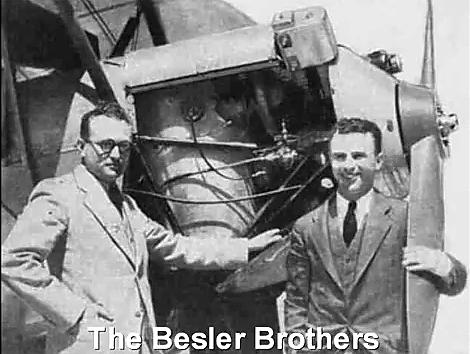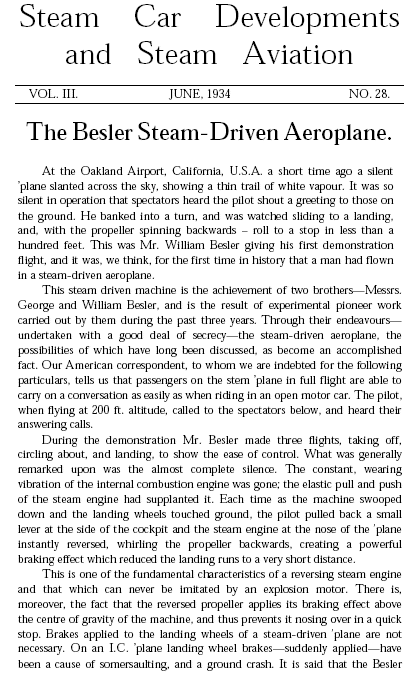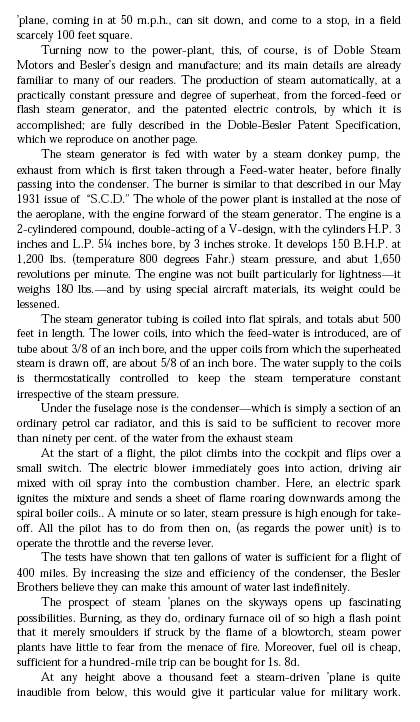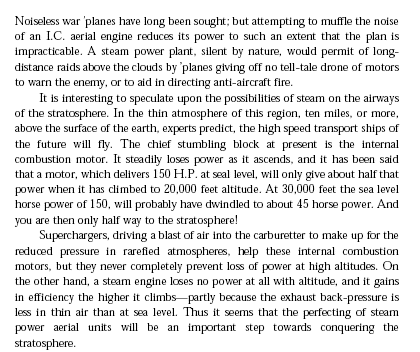Trains? 'Nope - but something just as fantastic!!
 |
Left: The Besler brothers with the converted plane The cylindrical steam-generator can be seen between the two men. |
 |
Left: A report on the Besler Steam Plane
From "Steam car Developments and Steam Aviation" No 28, June 1934.
|
 |
Left: A report on the Besler Steam Plane
Here we learn that the Doble-Besler engine generated 150 BHP with steam at
1200 psi- a healthy power output and an impressively high pressure. Note however
that other sources (see above) gave the power output as 90 HP.
|
 |

1927 Travel Air 2000 The first production Travel Air B established such a good reputation in the First National (Ford) Air Tour in 1925 that the company sold 19 the same year. In 1928 the model B was designated the Model 2000. Orders increased until 1930, when Model 2000 production ceased, with 1,550 built. One of the classic aircraft of the late 1920s, the Travel Air 2000 replaced the aging Curtiss Jenny trainer that was fast becoming ragged due to its popularity on the barnstorming circuit. Designed with the local airport operator in mind, the rugged, all-purpose trainer was produced with a liquid-cooled, V-8 Curtiss OX-5 engine, one of the most economical and available due to the large military surpluses. It is not surprising that the Travel Air was a good airplane considering that Walter Beech, Clyde Cessna, and Lloyd Stearman were all involved in its design and production. This resource of talent produced an aircraft that was known for reliability, ease of maintenance, and a delight to fly. With a range of 425 miles, barnstormers could hop passenger rides in and out of small fields all day. Take note of the leading edge of the fin where it is attached to the fuselage - it is possible to adjust the amount of compensation for slipstream effect. Also notice the huge balanced ailerons giving the plane the nickname Old Elephant Ears. Because of a superficial resemblance to Fokker D.VIIs, Travel Airs frequently represented Fokkers in the World War I flying films of the 1920s and 1930s, earning them the nickname "Wichita Fokker". In Canada the Travel Air was used for training and some charter work. One was used as a corporate aircraft by the Walter M. Lowney Co. Bush pilots in Canada and Alaska discovered the ruggedness, load carrying ability, and dependability of the Travel Air, and it became the bush plane of choice for many. One of the more famous companies to use Travel Airs was Johnson's Flying Service of Missoula, Montana. Once described as a "virtual air force of old planes", Johnson's maintained Forest Service contracts well into the 1960's and used both Ford Tri Motors and Travel Airs on floats or wheels to haul smoke jumpers and freight to remote regions. Because of their classic design, many Model 2000s have been restored and are still flying. |
| Specifications: | |
| Wing Span: | 34 ft 8 in (10.6 m) |
| Length: | 24 ft 2 in (7.4 m) |
| Height: | 8 ft 11 in (2.7 m) |
| Weight, Empty: | 1,335 lb. (605 kg) |
| Weight, Gross: | 2,180 lb. (989 kg) |
| Cruising Speed: | 85 mph (137 km/h) |
| Max Speed: | 100 mph (161 km/h) |
| Rate of Climb: | 520 ft (158 m)/min |
| Service Ceiling: | 10,000 ft (3,050 m) |
| Range: | 500 mi. (805 km) |
| Power Plant: | one Curtiss OXX-6, 100 hp, Vee engine |

First Flight: March 1925 (model 1000)
| Select the thumbnail to see a larger versions of each picture. | |
 |
 |
I guess that would be a 0-2-1.
ReplyDeleteBy comparison a 747 would be a 2-16-0 if it was steam powered.
Neat post.
I had never seen that video and I spent my working life as an aircraft engineer. (electrical / avionics)
Terry
Fla.
0-2-1 : Hah! Good one, Terry! Glad you enjoyed it!
DeleteGotta love the music and the old cameras, too!
ReplyDeleteI bet you did the Charleston, too - I did (when Hubby wasn't around! LOL)
Delete